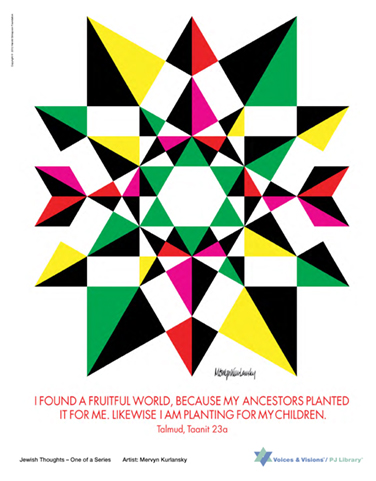
"I found a fruitful world, because my ancestors planted it for me. Likewise I am planting for my children."
-Talmud, Taanit 23A
Voices & Visions Dvar Torah
Congregation B'nai Torah - Forest Park Minyan (Springfield MA)
Shabbat Re'eh, August 3, 2013
By Bob Dashevsky
This Talmudic quote prods us to consider how we might work toward the well-being of future generations. Correspondingly, Shmittah (letting the land lie fallow one year out of seven), one of the many Mitzvot presented in Parshat Re'eh, is indeed a practice that safeguards posterity by protecting and enhancing the essential fertility of the soil.
I started thinking about the number "seven" as I contemplated Kurlansky's artwork and the quote that inspired the artist. There are a lot of "sevens" in Parshat Re'eh. "Seven" seems, in one way or another, to represent a transcendent or transformational counterpoint to "business as usual". Just think "Shabbat"!
Besides Shmittah, there are other "Sevens" in this week's Parsha: the Seven-Day festivals of Pesach and Sukkot, the Counting the Omer (seven weeks of seven days), the holidays of the Seventh Month, and the freeing of Hebrew slaves in the Seventh Year. And there are many other "Sevens" in our Tradition, including Sheva Brachot, which we celebrate tonight with our Chatan and Kallah, Rob and Gila. (Mazel Tov!)
The "Why" of "Seven", however, seems to defy logic. Could the human mind (without God's help) ever conceive of counting days in groups of seven to form something called "a week"? Days, of course, we understand – the rising and setting of the sun. Months we understand – the phases of the moon. Years we understand, the cycles of the seasons. But what’s logical about a week consisting of seven days??
So back to the poster. I have thus far found myself fighting with every piece in the "Voices & Visions" series. Kurlansky’s poster is no different. I initially asked myself whether the artist had any clue about the text that inspired his art. Why, when highlighting a teaching that employs the metaphor of the natural world and things that grow, does the artist create a work that is angular, geometrical, symmetrical, and decidedly inorganic?
Yesterday, I finally noticed that Kurlansky placed a Magen David at the center of his busy, colorful poster; it was not previously apparent to me. And for the first time, I realized that the geometrical, symmetrical six-pointed star underscores the primacy of "seven" in Judaism. Six points, representing the six weekdays or the six planting years or, indeed, the six days of Creation -- these surround a central hexagon, representing the centrality of Shabbat, Shmittah year and/or the perfect world of God's Creation.
Human beings, of course, are the ultimate beneficiaries of Shabbat, Shmittah and Creation. And I found myself wondering if Kurlansky was thinking of "people" when he designed the poster's periphery to contain 12 discrete elements -- count them! Are these the 12 tribes of Israel? With additional contemplation, the 12 elements began to look like tents to me – the tents used by the People in the desert as they made their way to the Promised Land.
Coming back full circle to Taanit 23a, the People -- once they crossed the Jordan River and conquered the land -- settled down and started to plant! They planted not only for themselves, but for their children, their children’s children and all the generations to come.
In the end, Kurlansky's poster makes great sense to me, and his artwork has led me to see our venerable Magen David with new eyes.
